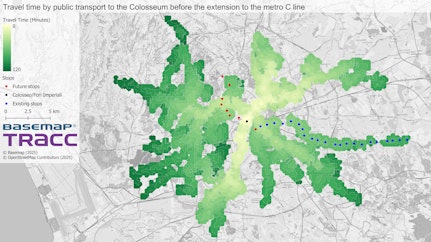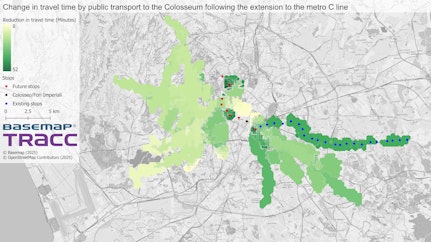



In March 2025 it was announced that the Capital City Council had approved a draft agreement for €4 billion financing for the extension on the metro line C in Rome. This extension will connect San Giovanni to Farnesina, including connections to Ottaviano which is served by Metro Line A and Colosseo which is served by Line B. Porta Metronia, Colosseo – Fori Imperiali, and Venezia stations are currently under construction.


We used TRACC to evaluate the impact of this expansion on connectivity in Rome. Using the newest DataCutter integration, the existing road and public transport network were imported into TRACC. This included both the bus network and the existing metro lines. Colosseo Station was used as the destination for the analysis due to it being a key interchange location and being located in the center of Rome and of the new metro line.
Using TRACC the proposed stations were added to the transport network and to the existing Line C with a travel time of approx. 2 minutes between each station. The frequency of the services was kept to roughly 9 minutes during the weekday AM peak to match the frequency of the existing timetable.
An Origin-Destination calculation was then used to analyse the travel time from a 250m grid of points to Colosseo Station for the current public transport network, and the extension to Line C.

The largest impact was seen along the Metro Line C due to the new connection and the reduced need for interchanges. By including Path Reports in the calculations, it is possible to see in greater detail how these journeys might change with the expansion of the line. For example, to get from Auditorium Station to Colosseo Station currently, the journey would require using the 932 Bus, as well as both the A and B Metro Lines. Following the expansion of the route this journey can now be completed using only the Metro Line C, reducing the journey time from 63 to 15 minutes. This was very quickly highlighted using the Results Comparison tool to compare the travel times in both scenarios simultaneously.
The impact of transport interventions can be carefully considered at both a large scale and at a fine level of detail using TRACC. This ensures that decisions are well evidenced and that the best proposals can be put forward.
Watch our video for a more in-depth view of the results in TRACC!